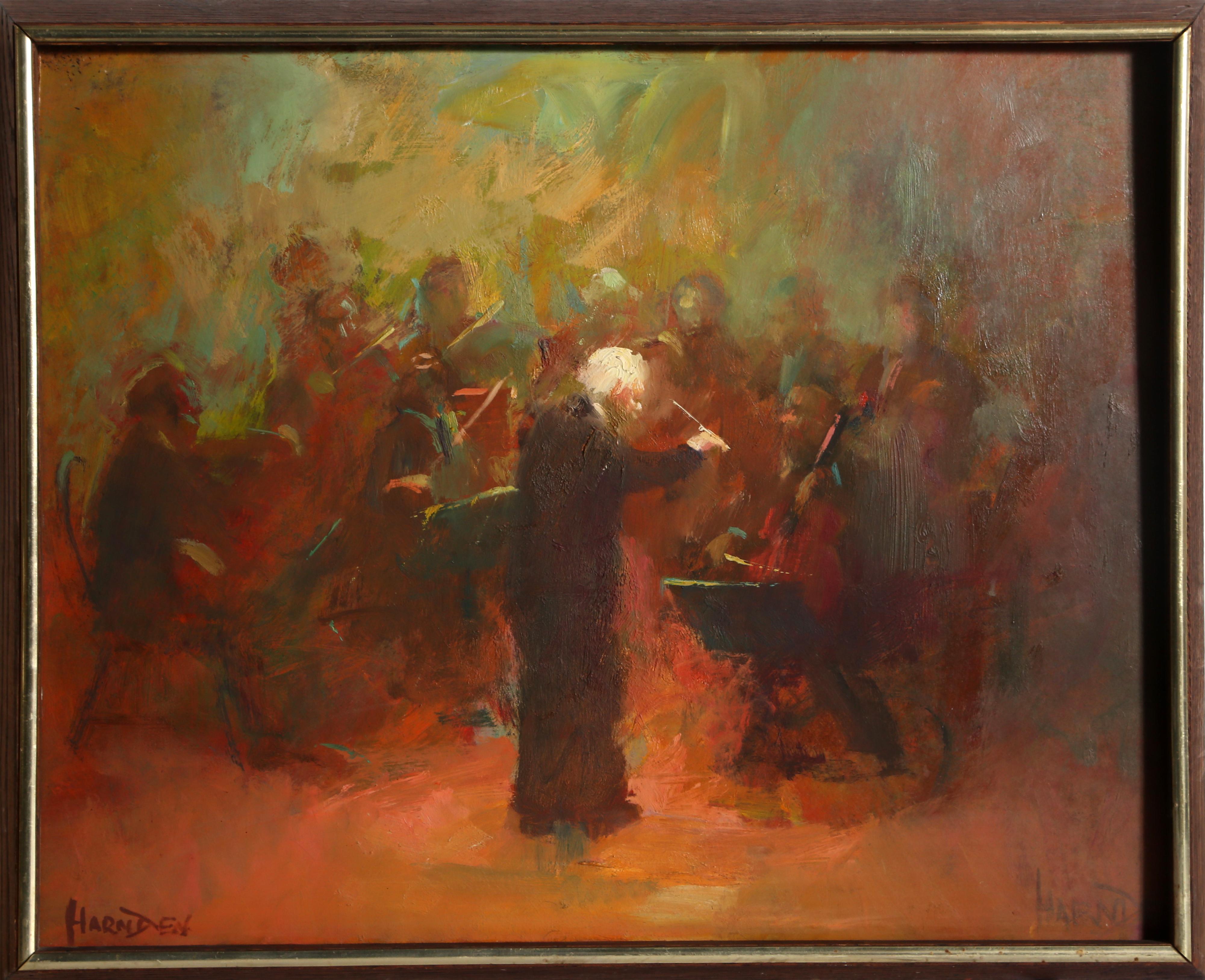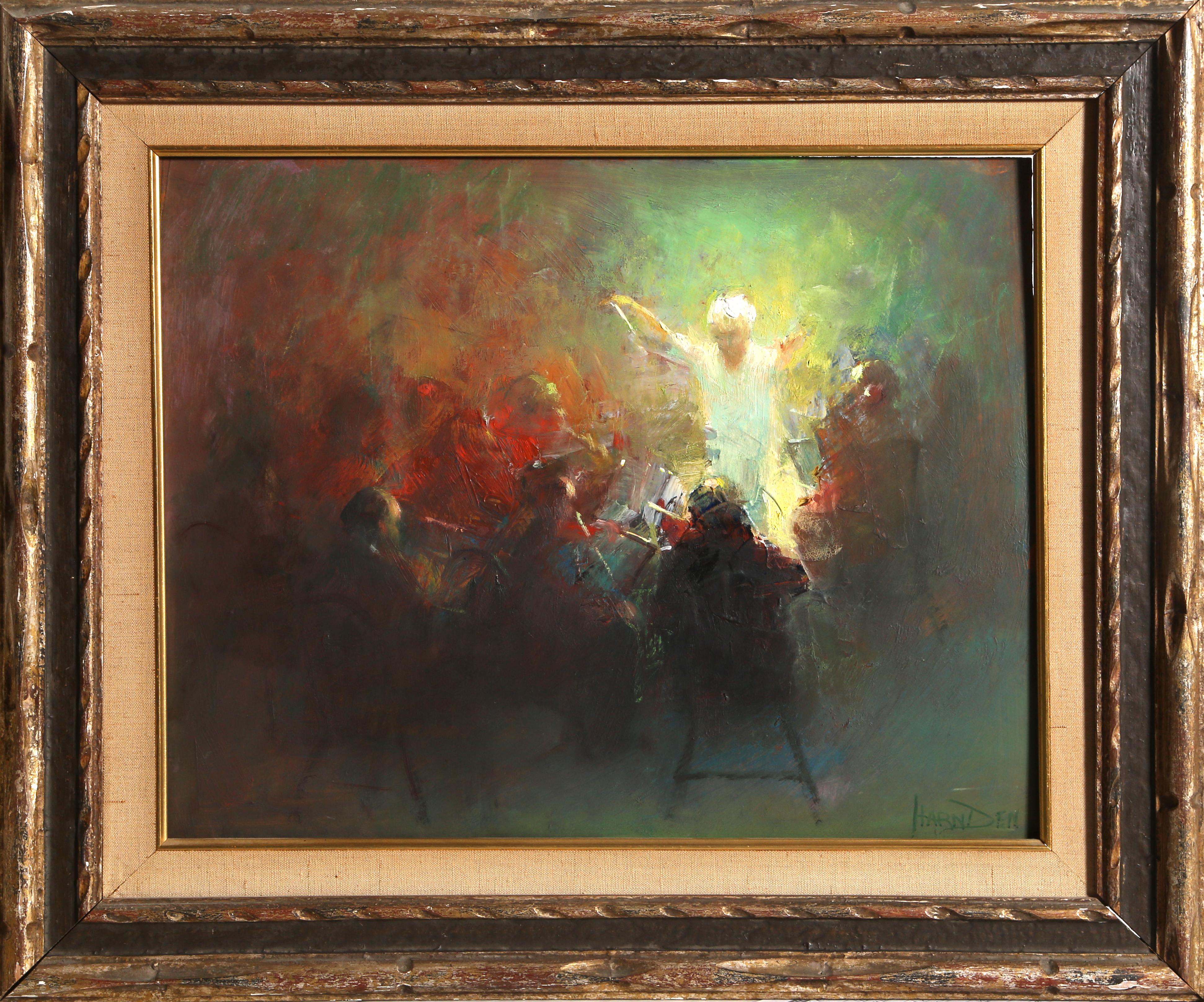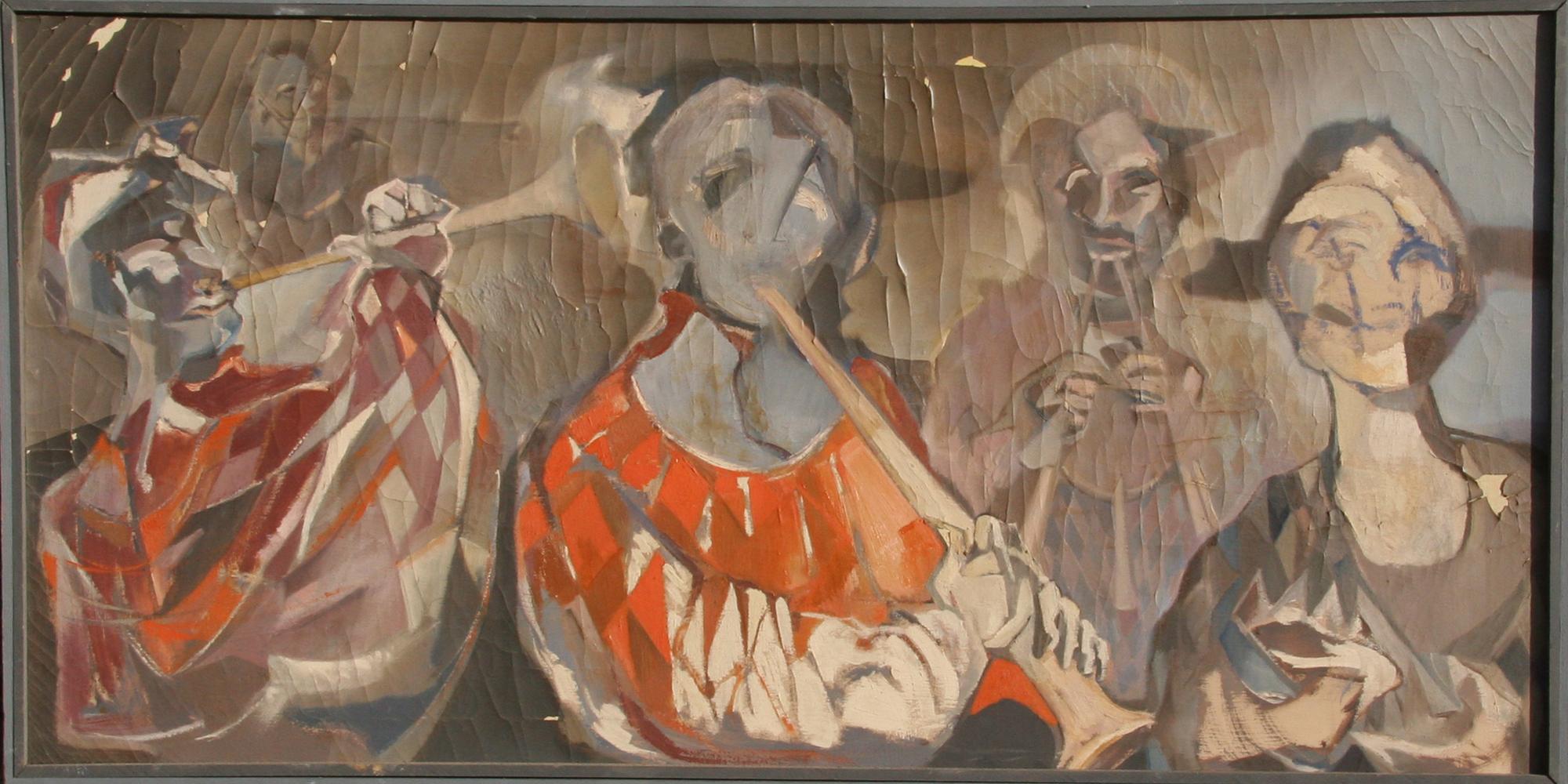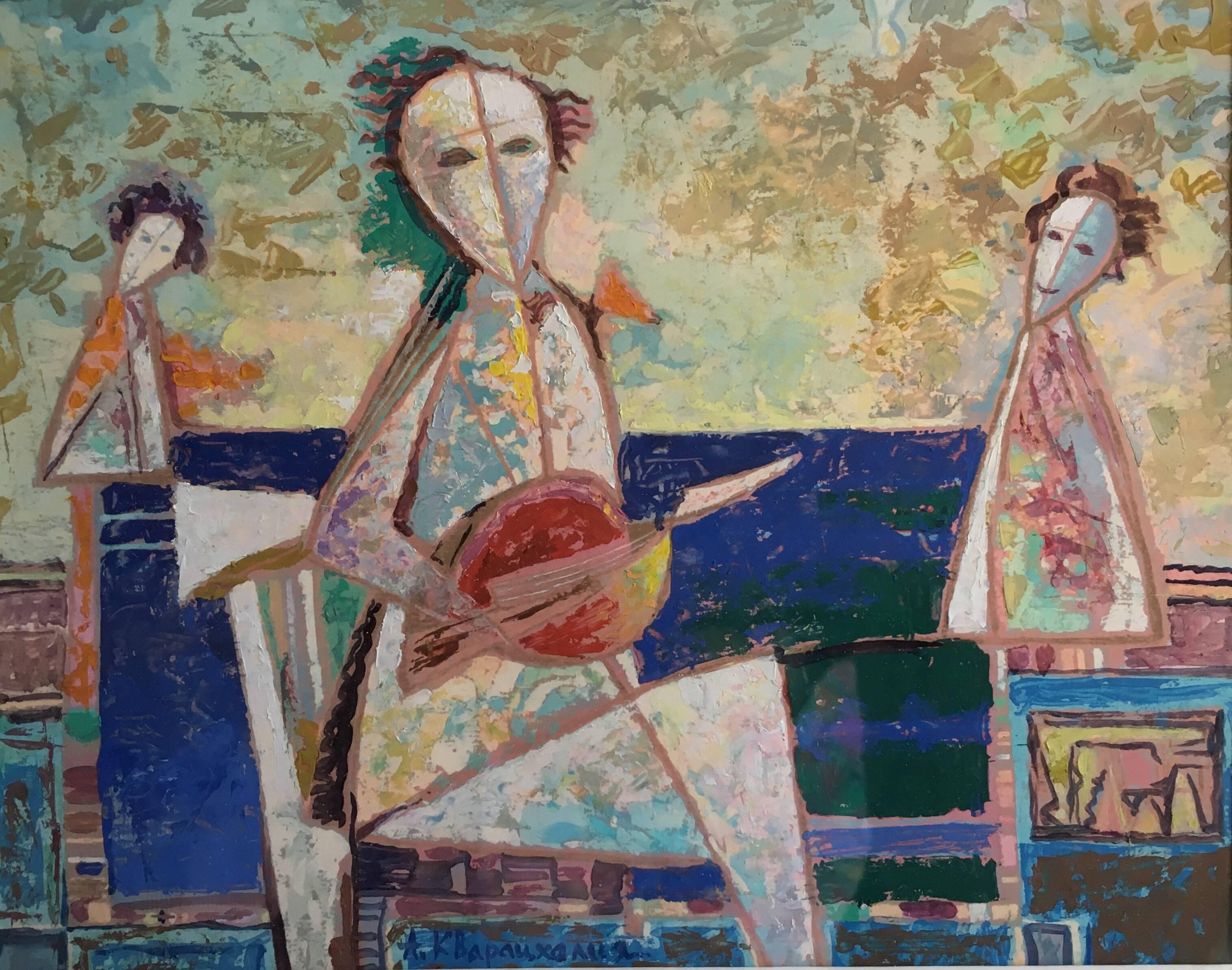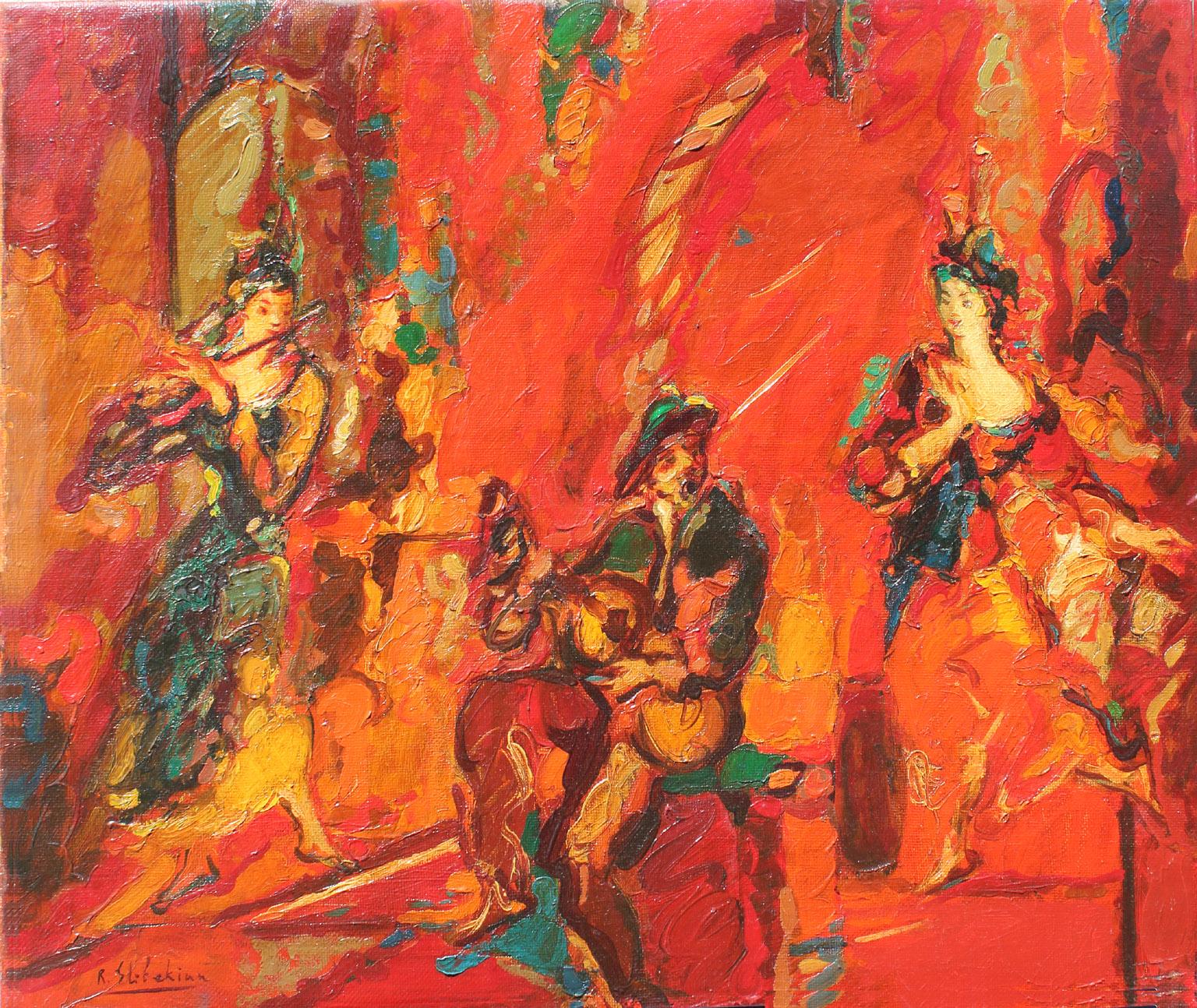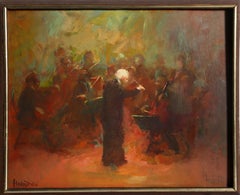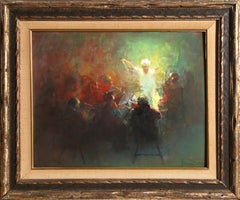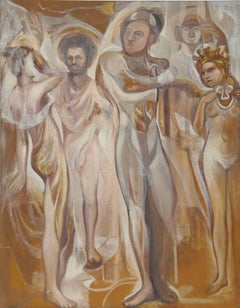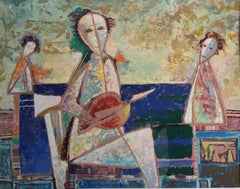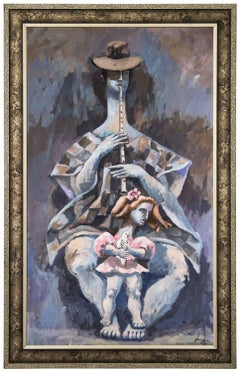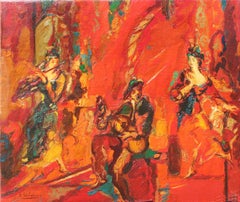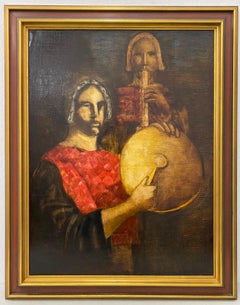Items Similar to Conductor with Singer, Figurative Oil Painting by William Harnden
Want more images or videos?
Request additional images or videos from the seller
1 of 8
William HarndenConductor with Singer, Figurative Oil Painting by William Harndencirca 1950
circa 1950
$2,000
£1,518.37
€1,736.69
CA$2,794.29
A$3,107.86
CHF 1,622.83
MX$37,819.36
NOK 20,725.99
SEK 19,437.32
DKK 12,961.56
Shipping
Retrieving quote...The 1stDibs Promise:
Authenticity Guarantee,
Money-Back Guarantee,
24-Hour Cancellation
About the Item
Artist: William Harnden, American (1920 - 1983)
Title: Conductor with Singer
Medium: Oil on Masonite, signed
Image Size: 11.5 x 23.5 inches
Frame Size: 17.5 x 30 inches
- Creator:William Harnden (1920 - 1983)
- Creation Year:circa 1950
- Dimensions:Height: 17.5 in (44.45 cm)Width: 30 in (76.2 cm)
- Medium:
- Movement & Style:
- Period:
- Condition:
- Gallery Location:Long Island City, NY
- Reference Number:Seller: RO724131stDibs: LU4663898272
About the Seller
4.9
Platinum Seller
Premium sellers with a 4.7+ rating and 24-hour response times
Established in 1979
1stDibs seller since 2014
3,069 sales on 1stDibs
Typical response time: 1 hour
- ShippingRetrieving quote...Shipping from: Long Island City, NY
- Return Policy
Authenticity Guarantee
In the unlikely event there’s an issue with an item’s authenticity, contact us within 1 year for a full refund. DetailsMoney-Back Guarantee
If your item is not as described, is damaged in transit, or does not arrive, contact us within 7 days for a full refund. Details24-Hour Cancellation
You have a 24-hour grace period in which to reconsider your purchase, with no questions asked.Vetted Professional Sellers
Our world-class sellers must adhere to strict standards for service and quality, maintaining the integrity of our listings.Price-Match Guarantee
If you find that a seller listed the same item for a lower price elsewhere, we’ll match it.Trusted Global Delivery
Our best-in-class carrier network provides specialized shipping options worldwide, including custom delivery.More From This Seller
View AllConductor with Orchestra, Figurative Oil Painting by William Harnden
By William Harnden
Located in Long Island City, NY
Artist: William Harnden, American (1920 - 1983)
Title: Conductor with Orchestra
Medium: Oil on Masonite, signed
Image Size: 15.5 x 19 inches
Frame Size: 18 x 21 inches
Category
1950s American Modern Figurative Paintings
Materials
Masonite, Oil
Mid-Concert, Figurative Oil Painting by William Harnden
By William Harnden
Located in Long Island City, NY
Artist: William Harnden, American (1920 - 1983)
Title: Concert
Medium: Oil on Masonite, signed
Image Size: 15.5 x 20 inches
Frame Size: 22.5 x 27 inches
Category
1950s American Modern Figurative Paintings
Materials
Masonite, Oil
Musicians, Abstract Oil on Board Painting by American Artist John F. Leonard
Located in Long Island City, NY
Musicians (7) by John F. Leonard, American (1921–1987)
Date: circa 1965
Oil on Canvas (unsigned)
Size: 23 in. x 47 in. (58.42 cm x 119.38 cm)
Category
1960s Abstract Figurative Paintings
Materials
Oil, Board
Regal Figures, Modern Oil on Board Painting by John F. Leonard
Located in Long Island City, NY
Regal Figures (64)
John F. Leonard
American (1921–1987)
Date: circa 1965
Oil on Board
Size: 26 x 22 in. (66.04 x 55.88 cm)
Category
1960s American Modern Figurative Paintings
Materials
Oil, Board
Trumpet Player, 1960's Oil Painting by Marshall Goodman
By Marshall Goodman
Located in Long Island City, NY
Trumpet Player
Marshall Goodman, American (1916–2003)
Date: circa 1960
Oil on Canvas
Size: 30 in. x 24 in. (76.2 cm x 60.96 cm)
Frame Size: 32 x 26 inches
Category
1960s American Modern Portrait Paintings
Materials
Oil
Rabbi, Oil Painting by Donald Roy Purdy
By Donald Roy Purdy
Located in Long Island City, NY
Artist: Donald Roy Purdy, American (1924 - )
Title: Rabbi 2
Medium: Oil on Masonite, signed l.r.
Size: 36 x 24 in. (91.44 x 60.96 cm)
Category
Late 20th Century Post-War Figurative Paintings
Materials
Masonite, Oil
You May Also Like
'Musicians' Surrealist Oil Painting of a Musician, Signed Oil Painting
By Alexei Kvaratskheliya
Located in Cirencester, Gloucestershire
'Musicians' Surrealist Oil Painting of a Musician, Signed Oil Painting
By Russian artist Alexei Kvarayskhelia, 20th Century
Signed by the artist on the lower left hand corner, also labelled on the back
Oil painting on card, framed
Frame size: 16 x 17 inches
Wonderfully stylish and unique oil painting. This surrealist painting of a band...
Category
21st Century and Contemporary Surrealist Abstract Paintings
Materials
Oil
The Musician, Large Lating American Modernist Oil Paintng
By Alexis Duque
Located in Surfside, FL
Alexis Duque
Imaginatively charting the psychological experience of space, Alexis Duque produces paintings and drawings of buildings and domestic interiors stacked and conglomerated ...
Category
21st Century and Contemporary Contemporary Figurative Paintings
Materials
Canvas, Acrylic
Robert Elibekian, Concerts, 25.5x19.5 in. Original oil on canvas
By Robert Elibekyan
Located in La Canada Flintridge, CA
Energy and life come together on this oil painting done by Robert Elibekian. Concerts, 25.5x19.5 in.
Robert Elibekyan was born in Tbilisi, Georgia. ...
Category
2010s Impressionist Figurative Paintings
Materials
Oil
Mid 20th Century "Musicians" Original Oil Painting
Located in San Francisco, CA
Mid 20th Century "Musicians" Original Oil Painting
Fine oil portrait of two musicians
One flute player, one drummer
Original oil on linen over board
Dimensions 31" wide x 40.5" h...
Category
Mid-20th Century Impressionist Portrait Paintings
Materials
Oil
Orchestra
By Lee Reynolds
Located in Los Angeles, CA
Figurative abstract oil on canvas of a performing orchestra.
Great colors and brushstrokes.
Signed lower right.
Category
1980s Abstract Impressionist Figurative Paintings
Materials
Oil
"Musical Conductor" Amy Londoner, Ashcan School, Figurative Concert Scene
By Amy Londoner
Located in New York, NY
Amy Londoner
Musical Conductor, 1922
Signed and dated lower right
Pastel on paper
Sight 18 x 23 inches
Amy Londoner (April 12, 1875 – 1951) was an American painter who exhibited at the 1913 Armory Show. One of the first students of the Henri School of Art in 1909. Prior to the Armory Show of 1913, Amy Londoner and her classmates studied with "Ashcan" painter Robert Henri at the Henri School of Art in New York, N.Y. One notable oil painting, 'The Vase', was painted by both Henri and Londoner.
Londoner was born in Lexington, Missouri on April 12, 1875. Her parents were Moses and Rebecca Londoner, who moved to Leadville, Colorado, by 1880. In 1899, Amy took responsibility for her father who had come to Los Angeles from Leadville and had mental issues. By 1900, Amy was living with her parents and sister, Blanche, in the vicinity of Leadville, Denver, Colorado. While little was written about her early life, Denver City directories indicated that nineteenth-century members of the family were merchants, with family ties to New York, N.Y. The family had a male servant. Londoner traveled with her mother to England in 1907 then shortly later, both returned to New York in 1909. Londoner was 34 years old at the time, and, according to standards of the day, should have married and raised a family long before. Instead, she enrolled as one of the first students at the Henri School of Art in 1909.
At the Henri School, Londoner established friendships with Carl Sprinchorn (1887-1971), a young Swedish immigrant, and Edith Reynolds (1883-1964), daughter of wealthy industrialist family from Wilkes-Barre, PA. Londoner's correspondence, which often included references to Blanche, listed the sisters' primary address as the Hotel Endicott at 81st Street and Columbus Avenue, NYC. Other correspondence also reached Londoner in the city via Mrs. Theodore Bernstein at 252 West 74th Street; 102 West 73rd Street; and the Independent School of Art at 1947 Broadway. In 1911, Londoner vacationed at the Hotel Trexler in Atlantic City, NJ. As indicated by an undated photograph, Londoner also spent time with Edith Reynolds and Robert Henri at 'The Pines', the Reynolds family estate in Bear Creek, PA.
Through her connections with the Henri School, Londoner entered progressive social and professional circles. Henri's admonition, phrased in the vocabulary of his historical time period, that one must become a "man" first and an artist second, attracted both male and female students to classes where development of unique personal styles, tailored to convey individual insights and experiences, was prized above the mastery of standardized, technical skill. Far from being dilettantes, women students at the Henri School were daring individuals willing to challenge tradition. As noted by former student Helen Appleton Read, "it was a mark of defiance,to join the radical Henri group."
As Henri offered educational alternatives for women artists, he initiated exhibition opportunities for them as well. Troubled by the exclusion of work by younger artists from annual exhibitions at the National Academy of Design, Henri was instrumental in organizing the no-jury, no-prize Exhibition of Independent Artists in 1910. About half of the 103 artists included in the exhibition were or had been Henri students, while twenty of the twenty-six women exhibiting had studied with Henri. Among the exhibition's 631 pieces, nine were by Amy Londoner, including the notorious 'Lady with a Headache'. Similarly, fourteen of Henri's women students exhibited in the groundbreaking Armory Show of 1913, forming about eight percent of the American exhibitors and one-third of American women exhibitors. Of the nine documented works submitted by Londoner, five were rejected, while four pastels of Atlantic City beach scenes, including 'The Beach Umbrellas' now in the Remington Collection, were displayed.
Following Henri's example, Londoner served as an art instructor for younger students at the Modern School, whose only requirement was to genuinely draw what they pleased. The work of dancer Isadora Duncan, another artist devoted to the ideals of a liberal education, was also lauded by the Modern School. Henri, who long admired Duncan and invited members of her troupe to model for his classes, wrote an appreciation of her for the Modern School journal in 1915. She was also the subject of Londoner's pastel Isadora Duncan and the Children: Praise Ye the Lord with Dance. In 1914, Londoner traveled to France to spend summer abroad, living at 99 rue Notre Dames des Champs, Paris, France. As the tenets of European modernism spread throughout the United States, Londoner showed regularly at venues which a new generation of artists considered increasingly passe, including the annual Society of Independent Artists' exhibitions between 1918 and 1934, and the Salons of America exhibition in 1922. Londoner also exhibited at the Morton Gallery, Opportunity Gallery, Leonard Clayton Gallery and Brownell-Lambertson Galleries in NYC. Her painting of a 'Blond Girl' was one of two works included in the College Art Associations Traveling Exhibition of 1929, which toured colleges across the country to broad acclaim.
Londoner later in life suffered from illnesses then suffered a stroke which resulted in medical bills significantly mounting over the years that her old friends from the Henri School, including Carl Sprinchorn, Florence Dreyfous, Florence Barley, and Josephine Nivison Hopper, scrambled to raise funds and find suitable long-term care facilities for Londoner. Londoner later joined Reynolds in Bear Creek, PA. Always known for her keen wit, Londoner retained her humor and concern for her works even during her illness, noting that "if anything happens to the Endicott, I guess they will just throw them out." Sprinchorn and Reynolds, however, did not allow this to happen. In 1960, Londoner's paintings 'Amsterdam Avenue at 74th Street' and 'The Builders' were loaned by Reynolds to a show commemorating the Fiftieth Anniversary of the Exhibition of Independent Artists in 1910, presented at the Delaware Art Center, Wilmington, DE. In the late 80's, Francis William Remington, 'Bill Remington', of Bear Creek Village PA, along with his neighbor and artist Frances Anstett Brennan, both had profound admiration for Amy Londoner's art work and accomplishments as a woman who played a significant role in the Ashcan movement. Remington acquired a significant number of Londoner's artwork along with Frances Anstett Brenan that later was part of an exhibition of Londoner's artwork in April 15 of 2007, at the Hope Horn...
Category
1920s Ashcan School Figurative Paintings
Materials
Paper, Pastel
More Ways To Browse
Valentino 2011
Adam Eve Oil Canvas
Bathing Cap
Bob Ross Originals
Chairs Virginia House
Dior Baby Blue
Dutch Painting Church Interior
Framed Sari
Giovanni Bellini
Jasmine Painting
Mohamed Abla
Palais Garnier
Pas De Calais
Pensive Girl
Polynesian Painting
Steve Husband
17th Century Tavern Scene
Art Deco Jazz Painting
